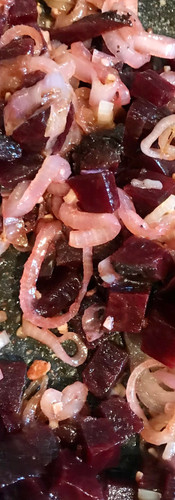Mustard chicken with beetroot soured cream spätzle
- Hobbychef

- Jun 5, 2024
- 5 min read
This mustard chicken with beetroot soured cream spätzle is a gorgeous combination of North German Baltic flavours that's suitably filling, but light enough for warm summer weather. It's a balancing act of the peppery kicks of mustard and horseradish and the sweetness of beetroot and apple.

Peppered with details
Mustard chicken with beetroot soured cream spätzle is not so much one traditional recipe as my conflation of two separate dishes I encountered on the North German islands of Sylt and Rügen. I've replaced the sautéd potatoes with which the chicken was served on the former with the beetroot soured cream spätzle I encountered on the latter, where it was served with pork medallions. So there are some additional mix 'n match ideas for you.
I love good German food and especially love the regional herbs and spices often used in North German cooking—mustard, horseradish, caraway seeds, curly parsley—and the way apples are used in savoury dishes.
In this version I am using some ingredients that are not as easy to find outside of Germany or Northern Europe as well as ingredients easily found in many countries around the world, but would have used specific German ingredients had I had them to hand. So, I'm listing both options in the list of ingredients.
You can use any type of spätzle, dried, fresh or frozen and you can even make your own from scratch; the type with egg or without. I'm using a fairly small artisanal egg variety. You can find the dried versions in many larger supermarkets or specialist delis in many countries.
In these quantities, there are nice little kicks of peppery flavours here and there, but it isn't particularly spicy. If you prefer your pepperiness on the hotter side, use more mustard and horseradish.
This recipe is for 2 adults, and is easily scaled for larger dinning parties. But please note, the photos actually show quantities that are disproportionate to the recipe quantities below since many elements of this dish—such as the spätzle or chicken—are great as leftovers. So I often cook quantities with that in mind.
3 top tips to get this recipe right: |
|
|
|
Shopping list
for the mustard chicken
2 skinless chicken breasts, if large, cut in half vertically
2 large rashers of bacon ( or slices of Black Forest ham)
2 peeled and cored fresh apples, roughly grated
2 tspns caraway seeds
Approx. 125ml plain yoghurt
Approx. 1.5 tbspns apple cider vinegar (or white wine vinegar)
3 heaped tspns whole grain mustard
A little rapeseed oil (or sunflower oil), optional
salt and pepper to taste
for the beetroot soured cream spätzle
Approx.150g (dried) spätzle
3 small cooked beetroot (or pickled beetroot); drained and cubed
2 tspns of fresh garlic, finely chopped (optional)
3 echalion shalllots (or an onion), finely cubed
2 heaped tspns creamed horseradish
Approx. 150ml soured cream
A generous clutch of curly leaf parsley, chopped
Approx. 1tbspn rapeseed oil (or sunflower or butter equivalent)
salt and pepper to taste
for the vegetable side
Approx. 180g fresh fine green beans, or kale or a green salad—such as one that features Lamb's lettuce (Feldsalat) prominently— if you prefer
Cooking Method
the mustard chicken
Make your marinade first. Grate the apple in a mixing bowl, immediately adding the vinegar and yoghurt, which will prevent it browning. Add in the caraway seeds and whole grain mustard and fold in, seasoning liberally with black pepper and salt. The result will look more like a salsa or salad than a marinade. This is how it is meant to be; not too liquid. Spread some of it across the bottom a suitable container with a lid. Place the rest over the chicken, pressing it in so that all of the flesh is covered. Store in the fridge and marinade for at least 6 hours before cooking
Using clean fingers, place the chicken onto a non-stick baking tray ensuring that about half of the marinade is piled on top of it. Cook in the middle of a fairly hot oven (200°C) for about 10 to 15mins; until the chicken is roughly half-cooked
As soon as it is cool enough to handle, spoon the rest of the marinade on top of the chicken and gently drape the bacon over it, tucking tightly at the sides. Season with fresh black pepper and return to the over until the bacon and chicken are optimally cooked—approx. 15 to 20mins. NB: if the bacon is optimally crisped but you're concerned that the chicken is not fully cooked, gently lift the bacon "lids" off using clean fingers and place to one side. Replace on top of the chicken once it is optimally cooked while it rests in the hot oven before plating so that is reheats
Plate and take to table, serving with the spätzle and side vegetables

the beetroot soured cream spätzle
You can do this in advance, or while roasting the chicken. Heat the oil on a medium heat in a frying pan. Add the shallots and sauté. When they begin to soften, add the garlic (if using) and stir in. When the shallots begin to caramelise, remove from the heat and place to one side
When—or just before—you begin the second stage of oven-cooking the chicken, bring a pot of salted water to the boil and boil the spätzle until ready, usually 10 to 12mins with the dried variety
About 3mins before your spätzle are cooked, add the beetroot to the pan of shallots and reheat on a medium-high heat, further caramelising the shallots and fully heating the beetroot. While you're doing this, stir the creamed horseradish into the soured cream container
Drain the cooked spätzle and return to the hot—but fully drained—pot. Add the beetroot and shallots and fold in. Add the soured cream and fold in. Finally add the chopped parsley and fold it in too. Re-cover while you plate the chicken and side vegetable dish
Plate and take to table

the green vegetable side dish
I've opted for fresh fine green beans simply steamed. Whether you go for a salad, cabbage or kale, keep it really simple: the flavours in the two main components are specific enough and you don't want to overcomplicate it
Alternatives
This dish is really hard to get to a vegan or vegetarian alternative since it relies heavily on meat. That said, the beetroot soured cream spätzle works fabulously as a lacto-vegetarian main course, especially with the addition of large slices of mushrooms at the stage you're cooking the shallots. And, indeed, it makes a great vegan dish if you add grated apple at the stage at which you're adding the beetroot to the shallots and dress with caraway seeds and rapeseed oil in lieu of soured cream.
My favourite pescatarian version is to replace the chicken with a white fish such as sole, cod or sea bass, pan-seared, adding a little whole grain mustard and samphire (Queller) during the cooking.
Pairings
Despite the "stodge" of the the spätzle and the bacon, this remains a pretty light dish and white always seems the best match for me; a decent riesling—German or New World—or a natty little Grüner Veltliner, though specifics escape me. I distinctly remember liking it with a Côtes de Gascogne Colombard but, again, specifics escape me.
It's also great with chilled Apfelsaftschorle—for obvious reasons—or simply with chilled sparkling water.
I'm sure there must be beers that work well with it, but I have never got around to them so far.
























Comments